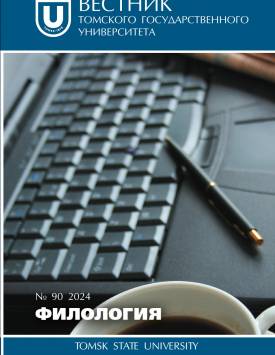Sprachbund and Kulturbund: Methodology for regular correspondences
The article aims to address the theoretical question concerning the rigorous proof, through methods of the humanities, of the existence in human history of a special type of convergent development of idioethnic languages and cultures, along with the observed outcome of such development - linguistic and cultural unions as distinct language groups (distinct from language families) and specific cultural associations. The Balkan linguistic union is recognized as a prototypical case of a convergent group of languages, although among Balkanists there is still no consensus either on the inventory of so-called Balkan linguistic features (Balkanisms) or on their areal and intrasystemic distribution. The completion of the ideographic, descriptive stage of Balkan studies in the 20th and 21st centuries has allowed for a transition from making brief inventories of “most important similarities” and lists of hundreds of interlanguage parallels to overcoming research atomism and establishing rules for the distribution of inter-Balkan similarities and differences in diachrony and diastratic variation, forming a conception of the complexity of the Balkan linguistic area and its numerous major and minor components, of the areal distribution of similarities and differences among Balkan languages. In this process, the shortcomings of nomothetic explanatory approaches to linguistic union in general have become evident, leading to aporias regarding the number of languages necessary and sufficient for recognizing a certain group as a union, and the impossibility of establishing its (geographical) boundaries. Attempts to reduce the “Balkan linguistic type” to general communicative characteristics of oral speech, analyticity, redundancy, ambivalence, and ultimately to hierarchies of borrowing, have also proved to be of little utility. Searches for donor languages of linguistic Balkanization (acquisition of so-called Balkanisms - convergent features recognized as unionforming) have not yielded convincing results. In the 2020s, in Russia, it became possible to formulate a new definition of linguistic and cultural union: its diagnostic signs should be considered as regular, systematic functional correspondences between languages and cultures (analogous to the presence of regular phonetic correspondences between languages as a diagnostic sign in the theory of language relatedness). Regular functional correspondences between languages and cultures are non-random coincidences in sets/inventories of broadly understood functions (distribution rules, meanings) of units and categories of different languages and cultures. The article proposes an algorithm for their detection. At least two idioethnic languages/dialects belonging to at least three different language families and prevalent in one geographical area are selected. Speakers of these idioethnic languages/dialects are considered as carriers of the corresponding cultures. A holistic approach to language and culture is applied: the inventory (core, central, or basic) of units and categories of each language and culture of all structural levels is established. Rules of functional distribution of units in each language and culture are determined. Isofunctionality of the core function of a unit and the core meaning of a category of language and culture in non-related languages is established. Correspondences between distribution rules of units (operation rules of categories) of language and culture in non-related languages are sought. Inventories of categorical units and functional amplitudes are mapped for languages included in the survey grid, aiming to detect areal structures. Linguistic and cultural unions are not speculative constructs of linguists and anthropologists, but an ontological reality. The author declares no conflicts of interests.
Keywords
linguistic and cultural convergence, linguistic and cultural contacts, linguistic union (Sprachbund), cultural union (Kulturbund), ethnolinguistic atlasesAuthors
| Name | Organization | |
| Sobolev Andrey N. | Institute for Linguistic Studies of the Russian Academy of Sciences | andrey.n.sobolev@mail.ru |
References

Sprachbund and Kulturbund: Methodology for regular correspondences | Vestnik Tomskogo gosudarstvennogo universiteta. Filologiya – Tomsk State University Journal of Philology. 2024. № 90. DOI: 10.17223/19986645/90/7
